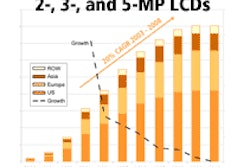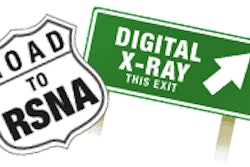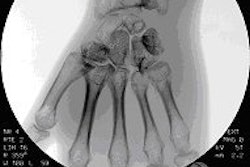An iso-osmolar contrast agent, iodixanol, is pricier than a low-osmolar agent, iohexol, but it may actually be more cost-effective for angiographic exams in diabetics with renal impairment, according to new research by the authors of the Nephrotoxic Effects in High-Risk Patients Undergoing Angiography (NEPHRIC) study.
In an update to previous NEPHRIC research, Dr. Peter Aspelin and colleagues analyzed the cost implications of using both contrast agents. Aspelin is from Karolinska University Hospital in Stockholm, Sweden.
The patient population consisted of 125 patients from 17 European centers, with 61 patients in the iodixanol (iso-osmolar agent Visipaque, GE Healthcare, Chalfont St. Giles, U.K.) group and 64 in the iohexol (low-osmolar agent) group. Data were collected until the patients were discharged, but not beyond a month after the angiography.
The costs were calculated as a product of the units of resource utilization recorded and the appropriate country-specific unit prices, and expressed in 2003 euro values. Unit prices for years other than 2003 were adjusted using country-specific consumer price indexes, the authors stated. The nonparametric bootstrap method, a statistical resampling approach, was employed to adjust for skewed distribution in patient-level cost data.
The research group found the average cost associated with treating adverse drug reactions per patient for the low-osmolar agent iohexol was a whopping 373 euros in Sweden, 399 euros in Germany, and 445 euros in France. In comparison, the average cost associated with treating adverse drug reactions for the iso-osmolar agent iodixanol was 1.8 euros in Sweden and less than 1 euro in Germany and France.
The price difference between iodixanol and the less-expensive iohexol was 9 euros in Sweden, 122 euros in Germany, and 6 euros in France based on the published prices of the contrast agents in these countries.
"The cost of treating adverse drug reactions mainly resulted from management of ARFs (acute renal failures) in the iohexol group," the researchers wrote (American Heart Journal, February 2005, Vol. 149:2, pp. 298-303).
The iohexol group had seven serious drug reactions, of which six were ARFs as a result of contrast-induced nephropathy (CIN). In the iodixanol group, there were two nonserious drug reactions.
"Although contrast medium costs for the IOCM (iso-osmolar contrast media) iodixanol were higher per patient than for the LOCM (low-osmolar contrast media) iohexol in each of the three countries, the higher unit price of iodixanol was offset by the lower cost associated with treating fewer adverse drug reactions in the iodixanol group," the authors explained.
The researchers also calculated the average hospital costs per patient for the two agents, although the costs were not part of the cost-effectiveness analysis. For the iohexol group, the average hospitalization cost was 2,467 euros in Sweden, 2,092 euros in Germany, and 2,147 euros in France. In the iodixanol group, the costs dropped to 1,978 euros in Sweden, 1,519 euros in Germany, and 1,754 euros in France.
When each of the three sets of country-specific unit costs were used, iodixanol had a lower mean adverse drug reaction cost, as well as an improved mean effect, the group stated.
Assessment of the variability of the costs showed that iodixanol was less expensive and more effective in 91% of the Swedish bootstrap analysis, 72% of the German bootstrap samples, and 92% of the French bootstrap samples, they added.
In their 2003 NEPHRIC study, the group found that the incidence of CIN was 3% in the iodixanol group versus 26% in the iohexol group, hence the odds of nephropathy were 11 times as high with iohexol as with iodixanol (New England Journal of Medicine, February 2003, Vol. 348:6, pp. 491-499).
Incidence of CIN associated with iohexol is also higher in high-risk groups such as patients having diabetes with renal impairment -- it is less than 2% in the general population, but 12% to 50% in these for high-risk patients, according to the original NEPHRIC study.
"In addition to the patient benefits associated with a reduction in contrast media-related adverse reactions, there are cost benefits related to the lower resource utilization necessary when a contrast agent associated with fewer adverse reactions is used," the researchers wrote of their current study.
By N. Shivapriya
AuntMinnie.com contributing writer
April 14, 2005
Related Reading
Sodium bicarbonate may prevent radiocontrast-induced renal injury, May 19, 2004
Radiocontrast-induced nephropathy poses serious risk in patients, study shows, September 3, 2003
Iso-osmolar contrast agent less likely to be nephrotoxic in high-risk patients, February 6, 2003
Acetylcysteine helps prevent nephrotoxicity during coronary angiography, February 6, 2003
Copyright © 2005 AuntMinnie.com



















